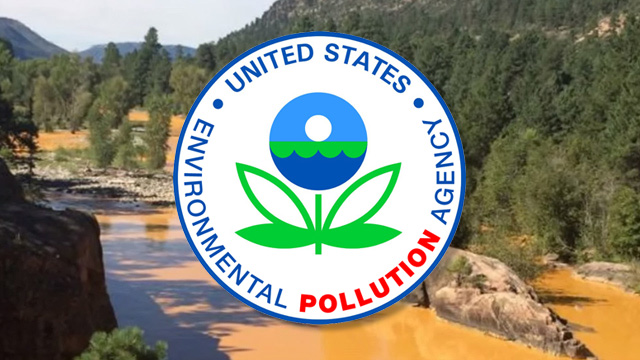After decades of high cancer rates and birth defects, EPA finally begins cleanup of Navajo reservations
Friday, September 30, 2016 by: Daniel Barker
Tags: uranium mines, Navajo reservations, EPA

(NaturalNews) It's a shameful fact that Native American communities remain among the most economically-disadvantaged and environmentally-impacted in our nation. And among the various tribal nations, none have suffered more than the Navajo people whose lands and waters have been poisoned from decades of uranium mining.
But Navajo reservations may now finally receive some long overdue help in cleaning up the mess created by uranium mining companies over the last 60 years.
The Environmental Protection Agency (EPA) announced on August 31 that it is now seeking $85 million worth of bids from environmental assessment companies to begin documenting the extent of the damage in preparation for new cleanup efforts.
The cleanup operations will be funded in part by a $1 billion dollar bankruptcy settlement levied against Tronox Incorporated (formerly known as Kerr-McGee), which operated uranium mines throughout Navajo lands.
More than 500 uranium mines on Navajo lands, some extremely dangerous
There are more than 500 mines in the region that have already been identified, but there are estimated to be hundreds more, and some are particularly dangerous to the environment and those living nearby.From Mint Press News:
"So far, 523 mines have been identified in the region, and the EPA and Navajo Nation have made a list of 46 which pose the greatest threat to residents or water sources. The EPA has cleanup agreements with 30 of the companies responsible for these mines, while the Justice Department will cover the cleanup costs for the remaining 16. Nine of these dangerous mines have already been targeted for treatment."
Many of the mines, which are located throughout parts of New Mexico, Utah and Arizona, are full of mining waste containing dangerously high levels of gamma radiation, which has led to contamination of water supplies and the poisoning of many members of the Navajo Nation.
The contamination has caused "increased rates of cancer, genetic defects, Navajo neurohepatopathy, and increases in mortality" among residents of the affected regions, according to Mnar Muhawesh, editor/publisher of Mint Press News:
"Lack of reliable access to clean, unpolluted water is a recurring issue for Native American and First Nations communities throughout North America. About 40 percent of the Navajo lack running water, with many depending on monthly water deliveries for survival."
As Muhawesh has noted, the Navajo Nation has for many decades endured a water contamination crisis that is "far worse and more persistent" than that of the residents of Flint, Michigan, who are still in the midst of a lead contamination problem that began in 2014 when that city's water supply was switched.
Sadly, the plight of the Navajo people has gone largely unnoticed by the press and, more importantly, by those responsible for cleaning up polluted sites – in other words, the EPA.
That may be beginning to change, but it's presumably of little consolation to those who have already been poisoned during decades of total neglect.
A history of exploitation and neglect
Native American communities are often affected by industrial pollution, as the reservations they have been herded onto by the U.S. government have been commonly exploited for natural resources such as gold, uranium and petroleum.And these industries have nearly always shown an utter disregard for the environment, not to mention the lives and culture of the Native Americans who live in these exploited regions.
Another example includes the disastrous King Gold Mine cleanup operation in Colorado conducted by the EPA, which in 2015 caused a spill of millions of gallons of toxic waste into the Animus River, leading to the contamination of hundreds of miles of waterways in three states, including areas of the Navajo Nation.
Currently, there is also a protest movement regarding the planned Dakota Pipeline project, which directly threatens the water supply and sacred burial sites of the North Dakota Standing Rock Sioux tribe. The protests now involve members of more than 100 Native American tribes who have banded together to oppose the project, but the outcome is still uncertain.
Meanwhile, the shameful treatment of our indigenous people continues – as it has for centuries – but the planned uranium mine cleanup operation at least offers some small hope for change.
Better late than never, I suppose. ...
Sources:
MintPressNews.com
MintPressNews.com
Science.NaturalNews.com
Uranium mines at FETCH.news
Get independent news alerts on natural cures, food lab tests, cannabis medicine, science, robotics, drones, privacy and more.
Take Action: Support Natural News by linking to this article from your website
Permalink to this article:
Embed article link: (copy HTML code below):
Reprinting this article:
Non-commercial use OK, cite NaturalNews.com with clickable link.
Follow Natural News on Facebook, Twitter, Google Plus, and Pinterest
- Warp Speed 2.0: Trump Administration ACCELERATES Gates-funded, self-amplifying bird flu vaccines
- DMSO and Natural Dyes: A suppressed cancer treatment resurfaces in independent research
- Transhuman vectors of disease: Young adults continue to produce spike proteins ONE YEAR after receiving COVID vaccine
- Aerosolized bioweapons? Strange “diploid biomasses” falling out of the sky in Florida captured under the microscope
- Study finds bananas more effective than salt reduction for lowering blood pressure
- Chemical cocktails in processed foods linked to diabetes, validating natural health warnings
- 8 U.S. states may EXPAND vaccine exemptions in 2025, and parents have many reasons to STOP THE SHOTS
- Prominent doctors call for new holistic therapies to address CANCER SPIKE: Tree barks provide anti-cancer treatment options
- STAGING BEFORE RELEASE: WHO Runs 2-Day Pandemic Simulation 'Exercise Polaris'
- Fermented foods like sauerkraut may outshine modern medicine in gut health, research finds
- Ancient mummies rewrite human history with “ghost” lineage discovery
- Mike Adams releases country western hit single: Goin’ Back in Time is Comin’ Home
- Surge in KIDNEY FAILURES linked to common medications
- Analysis: The coming economic collapse, a mass uprising and Trump's three secret weapons to halt the growing revolt
- Widespread social and economic unrest: Steve Quayle issues urgent financial warning of imminent asset collapse in new interview with Mike Adams
- Fauci is back in the limelight, and he’s busy promoting a future COVID or FLU pandemic
- Kiss Your Genetic Privacy Good-Bye! 23andMe Gets Green Light to Sell Your Intimate Genetic Details to Anyone They Want
- U.S. lawmakers investigate Meta over alleged China collaboration
- Israeli lobbyists boast of controlling US national security policy in leaked AIPAC audio
- Aerosolized bioweapons? Strange “diploid biomasses” falling out of the sky in Florida captured under the microscope
- Analysis: The coming economic collapse, a mass uprising and Trump's three secret weapons to halt the growing revolt
- Fauci is back in the limelight, and he’s busy promoting a future COVID or FLU pandemic
- Widespread social and economic unrest: Steve Quayle issues urgent financial warning of imminent asset collapse in new interview with Mike Adams
- Kiss Your Genetic Privacy Good-Bye! 23andMe Gets Green Light to Sell Your Intimate Genetic Details to Anyone They Want
- Mike Adams releases country western hit single: Goin’ Back in Time is Comin’ Home
- U.S. lawmakers investigate Meta over alleged China collaboration
- Tulsi Gabbard leads charge against the Biden regime’s global censorship of the 'Disinformation Dozen'
- Pfizer's RSV vaccine linked to preterm births as drug giant CONCEALED RISKS from pregnant women in unethical clinical trials
- Dane Wigington exposes climate engineering as ‘All-Out Weather and Biological Warfare’
- Shedding light on the dark side of MMR vaccines: How vaccinated individuals SPREAD MEASLES & put the vulnerable at risk
- TAKE IT DOWN Act advances in Congress amid free speech concerns
- CLOT SHOT PLANDEMIC UNFOLDING: Fibrous, rubbery clots caused by covid injections have prion-like seeding activity
- Chemtrails unveiled: How the CIA and Big Business are manipulating the weather for profit
- Curcumin’s ancient healing power supercharges muscle recovery, and its effects are compounded with anti-inflammatory foods and supplements
- Criminal referral requests filed against Fauci and top COVID officials in seven states
- Defunding DEADLY mRNA jabs: Government funding for mRNA technology being scrutinized and sidelined until proven "safe and effective" for real
- Newly released JFK files reveal Pentagon's role in creating Lyme disease and covid in the same lab
- Analysis: The coming economic collapse, a mass uprising and Trump's three secret weapons to halt the growing revolt
- Mike Adams releases country western hit single: Goin’ Back in Time is Comin’ Home
- Aerosolized bioweapons? Strange “diploid biomasses” falling out of the sky in Florida captured under the microscope
- Kiss Your Genetic Privacy Good-Bye! 23andMe Gets Green Light to Sell Your Intimate Genetic Details to Anyone They Want
- European Court of Justice: Healthcare professionals who promoted or administered COVID-19 vaccines are CRIMINALLY LIABLE for any harm caused
- Federal employees whine over DOGE's new directive requiring them to do a 5-point summary of weekly accomplishments
- Widespread social and economic unrest: Steve Quayle issues urgent financial warning of imminent asset collapse in new interview with Mike Adams
- U.S. approves new Russian ambassador as diplomatic thaw continues
- Government waste exposed: Hegseth supports Musk’s demand for accountability from federal workers
- Now you can HEAR chemistry: Health Ranger translates molecules into music in stunning video demonstration that will blow your mind (and your ears)
- Fauci is back in the limelight, and he’s busy promoting a future COVID or FLU pandemic
- CLOT SHOT PLANDEMIC UNFOLDING: Fibrous, rubbery clots caused by covid injections have prion-like seeding activity
- I Want My Bailout Money – new song released by Mike Adams
- I Want My Bailout Money – new song and music video released by Mike Adams
- Tulsi Gabbard leads charge against the Biden regime’s global censorship of the 'Disinformation Dozen'
- Trump administration poised to overhaul crypto regulations with new SEC leadership
- The Health Ranger releases “Vaccine Zombie” song and music video, using AI-animated zombies for the music video
- Red Cross issues warning to stop blood plasma donations from vaccinated people
- Scientists confirm: GENIUS brain function can be spontaneously unleashed in humans without any apparent cause
- EPA advisor admits the agency is funneling billions to climate groups ahead of Trump’s return to White House
- HYSSOP: What research reveals about the health benefits of this ancient holy herb
- Two containers with completed ballots fall out of truck in Florida
- Newly released JFK files reveal Pentagon's role in creating Lyme disease and covid in the same lab
- Global leaders unite to clamp down on “misinformation” with UN-backed Cascais Declaration
- Mike Adams releases country western hit single: Goin’ Back in Time is Comin’ Home
- BREAKING: 2025 NDAA authorizes mandatory military draft of WOMEN across America… as Pentagon pursues global NUCLEAR war with both Russia and China at the same time
- Michael Yon warns of a ZIONIST TAKEOVER in Trump’s second administration
- The Health Ranger releases “Vaccine Zombie” song and music video, using AI-animated zombies for the music video
- Ozempic and Wegovy weight loss drugs are injectable LIZARD VENOM PEPTIDES that may unleash a devastating wave of organ failure… side effects align with symptoms of SNAKE BITES
- BOMBSHELL: DNA testing kits are a SCAM to develop ethnic-specific bioweapons
- Israeli soldiers accused of even more torture and abuse in the West Bank
- I Want My Bailout Money – new song released by Mike Adams
- These 13 countries just signed an agreement to engineer a global FAMINE by destroying food supply
- NASA admits that climate change occurs because of changes in Earth’s solar orbit, and NOT because of SUVs and fossil fuels
- RFK Jr. clears key hurdle: Sen. Susan Collins backs controversial HHS nominee, signaling a new era for health policy
Science News & Studies
Medicine News and Information
Food News & Studies
Health News & Studies
Herbs News & Information
Pollution News & Studies
Cancer News & Studies
Climate News & Studies
Survival News & Information
Gear News & Information
News covering technology, stocks, hackers, and more



"Big Tech and mainstream media are constantly trying to silence the independent voices that dare to bring you the truth about toxic food ingredients, dangerous medications and the failed, fraudulent science of the profit-driven medical establishment.
Email is one of the best ways to make sure you stay informed, without the censorship of the tech giants (Google, Apple, Facebook, Twitter, YouTube, etc.). Stay informed and you'll even likely learn information that may help save your own life."
–The Health Ranger, Mike Adams











































